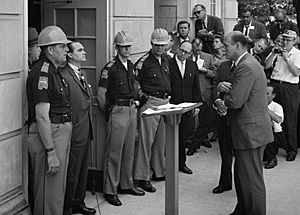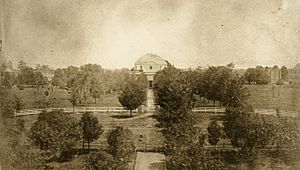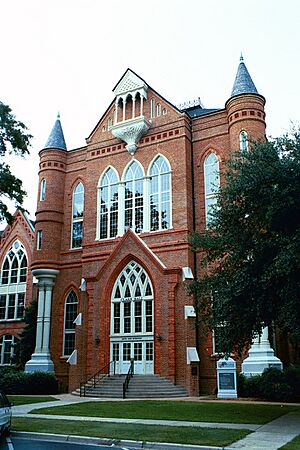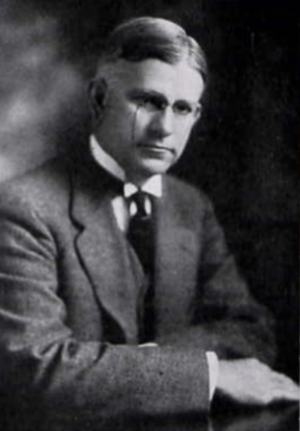History of the University of Alabama facts for kids

The University of Alabama is a super old public university in Tuscaloosa, Alabama. It's a big school where students can earn advanced degrees, like doctorates. It's known as one of the best universities in the state!
Contents
How the University of Alabama Began
The story of the University of Alabama started way back in 1818. The United States government decided to set aside land for a "seminary of learning" in the new Alabama Territory. Alabama became a state in 1819, and even more land was added for the school.
On December 18, 1820, the Alabama government officially created "The University of the State of Alabama." A special group of people, called the Board of Trustees, was put in charge. Their job was to build the campus and get the university ready for students.
In 1827, the Board chose Tuscaloosa as the perfect spot for the university. Tuscaloosa was actually the capital of Alabama at that time! The university finally opened its doors to students on April 18, 1831. Many of the early buildings were made from materials found right on university land, like sandstone and bricks.
Early Days: A Frontier School
The first president of the university was Reverend Alva A. Woods. He had studied at famous schools like Harvard and in Europe. President Woods wanted the university to be a very serious academic place.
However, Alabama was still a new state, and many students weren't ready for such high-level studies. For example, to get in, students needed to read Classical Greek and Latin! Because of this, only a few students who started actually graduated. In 1835, out of 105 students, only eight finished their degrees.
Even in these early days, students formed groups. The first ones were not social clubs, but academic debate societies. The Erosophic Society started in May 1831, and the Philomathic Society followed soon after.
Students lived in dorms like Washington Hall and Jefferson Hall. These buildings were three stories tall and held many students. Later, Madison and Franklin Halls were built. Today, the remains of Franklin Hall are still used for special ceremonies.
At the center of campus, there was a beautiful building called the Rotunda. It was a round, three-story building with tall columns. It had a chapel, a gallery, and the university library. Sadly, the Rotunda was destroyed by fire and was never rebuilt.
Greek life, like fraternities and sororities, began in 1847. The first fraternity was Delta Kappa Epsilon. At first, the university didn't like these secret clubs. But over time, more fraternities appeared. Women at the university started their own sororities, like Kappa Delta, in 1903.
The University During the Civil War
Student behavior was often a challenge in the early years. In the 1850s, President Landon Garland suggested turning the university into a military school. This idea became a reality in 1860, just before the American Civil War began.
Because it was a military school, the university trained officers for the Confederacy during the Civil War. This meant that in April 1865, Union troops burned down most of the campus. Only seven buildings survived. The President's Mansion was saved by Frances Louisa Garland, the president's wife, who bravely asked the soldiers to put out a fire there.
The university reopened in 1871. Soon after, it stopped being a military school. Some of the surviving buildings found new uses. Gorgas House, which was once a dining hall, is now a museum. The Observatory, which was for looking at stars, is now Maxwell Hall.
In 1880, the U.S. Congress gave the university land with coal on it. This was to help make up for the damage from the war. This money helped build new halls like Manly and Clark Halls. By 1900, the library, which had lost 7,000 books in the fire, had grown to 20,000 books thanks to donations.
In 1892, the university officially started admitting women. This happened after a lot of effort by Julia Tutwiler. At first, women had to be at least 18 and live in private homes, but they could study at the university.
A Growing University: Early 1900s
In 1903, the state government got rid of the military system at the university. Students really didn't like it, and this change made the university more popular.
Around 1906, the university started a fundraising campaign to celebrate its 75th anniversary. The money raised helped build new halls like Smith and Morgan Halls. These buildings were designed in a beautiful style called Beaux-Arts, which looked like old Greek buildings.
In the early 1900s, students had more freedom. New clubs appeared, like a glee club (for singing) and a drama club. The university also got its first yearbook and a student newspaper. Women's enrollment increased, and football became a huge passion!
On January 1, 1912, Dr. George H. "Mike" Denny became president. He had a huge impact on the university for many years. President Denny was great at making the most of the money he had to help the university grow. He called it "the Capstone" of education in Alabama.
He loved sports, especially football, and students really liked him. In 1929, students raised money to build a bell tower on campus in his honor. This tower is called Denny Chimes, and it's a beloved symbol for students and alumni.
In 1939, the Amelia Gayle Gorgas Library opened. It was built in the same spot where the old Rotunda used to stand. This library became a symbol of how the university kept moving forward while still honoring its past.
The University During World War II
When America entered World War II in 1941, the University of Alabama once again focused on training military members. Under President Raymond Ross Paty, the university ran one of the biggest military programs in the country.
Many male students left campus to join the war effort. The number of students dropped a lot during this time. Female students helped by hosting military members and wounded soldiers. Many students, teachers, and alumni joined the armed forces or helped in other ways related to the war.
By the end of the war, about 350 former students and one teacher had died fighting or from war-related causes. This included 13 players from the Crimson Tide football team.
Even though it was a tough time, the university also grew. It started doing more research, improved its library, and offered better benefits for teachers and staff. The University of Alabama Press was founded, which publishes books.
Growth and Change: 1946-2000
In 1953, a brave woman named Autherine Lucy sued the university. She wanted to stop the school from refusing to admit students just because of their race. In 1956, Autherine Lucy became the first African-American student to attend the university.
However, on her third day of classes, an angry crowd tried to stop her from attending. The police were called, but the university suspended Autherine Lucy, saying they couldn't keep her safe. Years later, in 1980, the university changed its decision. In 1992, Autherine Lucy even earned her master's degree from the university!
On June 11, 1963, Governor George Wallace tried to stop two African-American students, Vivian Malone and James Hood, from registering for classes. This event is known as the "Stand in the Schoolhouse Door" incident. Federal marshals arrived, and Governor Wallace eventually stepped aside, allowing the students to register. Later in his life, he apologized for his actions that day.
In 2010, the university honored Autherine Lucy, James Hood, and Vivian Malone. They dedicated the Malone-Hood Plaza and Autherine Lucy Clock Tower at Foster Auditorium. A tall brick tower with bronze plaques tells their important stories.
The 1970s and 1980s saw the university add many new programs and schools. These included schools for social work, nursing, and communication. The university kept growing and offering more choices for students.
The University in the 21st Century
In 2001, about 19,633 students were enrolled at the University of Alabama. Since then, the number of students has grown a lot! By 2017, a record-breaking 38,563 students were attending. The quality of students also improved, with many freshmen having excellent grades from high school.
To keep up with all these new students, the university built many new facilities. These included new dorms, research labs, and large classrooms that could hold 2,000 students. In 2010, the university bought the land where the old Bryce Hospital used to be. This greatly expanded the northern part of the campus, giving the university even more room to grow!






